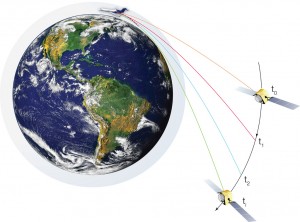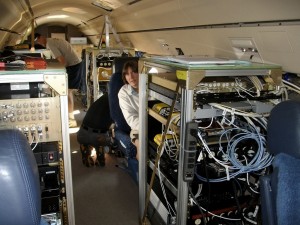First demonstration captures key meteorological data, offers potential of better hurricane forecasting
17 March 2014
LA JOLLA – GPS technology has broadly advanced science and society’s ability to pinpoint locations and motion, from driving directions to tracking ground motions during earthquakes. A new technique stands to improve weather models and hurricane forecasting by detecting precise conditions in the atmosphere through a new GPS system aboard airplanes.
The first demonstration of the technique, reported this month in the American Geophysical Union journal Geophysical Research Letters, is bringing the project’s leaders closer to a goal of broadly implementing the technology in the near future on commercial aircraft.

A new GPS system aboard airplanes could improve weather models and hurricane forecasting by detecting precise conditions in the atmosphere. “GISMOS” (GNSS [Global Navigation Satellite System] Instrument System for Multistatic and Occultation Sensing) communicates with satellites to define details of the atmosphere.
Credit: Scripps Institution of Oceanography
Current measurement systems that use GPS satellite signals as a source to probe the atmosphere rely on GPS receivers that are fixed to the ground and can’t measure over the ocean, or they rely on GPS receivers that are also on satellites that are expensive to launch and only occasionally measure in the regions near storms. The new system, used by geophysicist Jennifer Haase of the Scripps Institution of Oceanography in La Jolla, Calif., and her colleagues, captures detailed meteorological readings at different elevations in targeted areas of interest, such as where hurricanes might develop over the Atlantic Ocean.
“This field campaign demonstrated the potential for creating an entirely new operational atmospheric observing system for precise moisture profiling from commercial aircraft,” said Haase. “Having dense, detailed information about the vertical moisture distribution close to the storms is an important advancement, so if you put this information into a weather model it will actually have an impact and improve the forecast.”
“Satellite-based measurements are now regularly used for weather forecasting and have a big impact, but airplanes can go beyond satellites in making observations that are targeted right where you want them,” noted Eric DeWeaver, program director in the National Science Foundation’s (NSF) Division of Atmospheric and Geospace Sciences, which funded the research.
The paper details a 2010 flight campaign aboard NSF aircraft and subsequent data analysis that demonstrated for the first time that atmospheric information could be captured by an airborne GPS device. The instrumentation, which the scientists labeled “GISMOS” (GNSS [Global Navigation Satellite System] Instrument System for Multistatic and Occultation Sensing), increased the number of atmospheric profiles for studying the evolution of tropical storms by more than 50 percent.

Scripps Institution of Oceanography at UC San Diego geophysicist Jennifer Haase is seated at the controls of GISMOS, a 205-pound GPS atmospheric measurement system, testing the equipment prior to flights during a 2010 campaign. The equipment is installed in the cabin of a reconfigured Gulfstream V business jet.
Credit: Scripps Institution of Oceanography
“We’re looking at how moisture evolves so when we see tropical waves moving across the Atlantic, we can learn more about which one is going to turn into a hurricane,” said Haase. “So being able to look at what happens in these events at the early stages will give us a lot longer lead time for hurricane warnings.”
“This is another case where the effective use of GPS has the potential to improve the forecast and therefore save lives,” said Richard Anthes, president emeritus of the University Corporation for Atmospheric Research, which currently runs the satellite based GPS measurement system called COSMIC (Constellation Observing System for Meteorology, Ionosphere, and Climate).
While the current GISMOS design occupies a refrigerator’s worth of space, Haase and her colleagues are working to miniaturize the technology to shoe box size. From there, the system can more feasibly fit onto commercial aircraft, with hundreds of daily flights and a potential flood of new atmospheric data to greatly improve hurricane forecasting and weather models.
The technology also could improve interpretation of long-term climate models by advancing scientists’ understanding of factors such as the moisture conditions that favor hurricane development.
Notes for journalists
Journalists and public information officers (PIOs) of educational and scientific institutions who have registered with AGU can download a PDF copy of this article by clicking on this link: http://onlinelibrary.wiley.com/doi/10.1002/2013GL058681/abstract
Or, you may order a copy of the final paper by emailing your request to Nanci Bompey at [email protected]. Please provide your name, the name of your publication, and your phone number.
Neither the paper nor this press release is under embargo.
“First results from an airborne GPS radio occultation system for atmospheric profiling”
Authors:
J. S. Haase: Scripps Institution of Oceanography, University of California, San Diego, La Jolla, California, USA;
B. J. Murphy and P. Muradyan: Department of Earth, Atmospheric, and Planetary Sciences, Purdue University, West Lafayette, Indiana, USA;
F. G. Nievinski: Faculdade de Ciências e Tecnologia, Universidade Estadual Paulista, Presidente Prudente, Brazil;
K. M. Larson: Department of Aerospace Engineering Sciences, University of Colorado, Boulder, Colorado, USA;
J. L. Garrison and K.-N. Wang: Department of Aeronautics and Astronautics Engineering, Purdue University, West Lafayette, Indiana, USA.
Contact information for the authors:
Jennifer Haase, +1 (858) 534-8771, [email protected]
AGU Contact:
Nanci Bompey
+1 (202) 777-7524
[email protected]
Scripps Contact:
Mario Aguilera or Robert Monroe
+1 (858) 534-3624
[email protected]